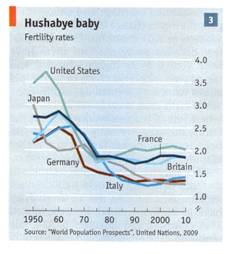
THE ECONOMIST vol 392 no 8637, “A slow-burning fuse,” page 5, “Suffer the little children” June 27, 2009. Information is from “World Population Prospects, United Nations 2009.
ECONOMIST Squeaks Up:
My favorite newspaper, after the GLEANER, is the ECONOMIST. Their reports are lively, timely, authoritative, and - except for the tragedies - the reports are hugely enjoyable. But even with them I sometimes wonder whether they are man or mouse.
This week (and it is June 27, 2009 as I write) they published an entire section on ageing populations and the resultant implications. The outlook is “scary,” their word not mine. They had said in an earlier article on the subject that this was the most important thing going on in the world. This time for emphasis they compare it with the cost of the recent economic melt down. Ageing over the next few decades will cost many times as much as the recession has.
They lead off with the observation that people are living longer, which is a good thing although not a cheap thing. Then they get to the point and say that falling birth rates is far more important, that it is now below replacement in the rich part of the world with the rest of the world only a few decades behind.
Their suggestion is basically that people are going to have to work longer into adulthood. That is not difficult for me to imagine. Most of my ancestors lived to be quite old for their times, and most worked far past what is now considered retirement age. Yes, it can be done. So it is a good suggestion.
But at heart, stability will never come until the birth rate stabilizes at replacement levels. Some countries in the rich world seem to have had a recent rally. That is good. Some of it must be due to government expenditures to make having a family cheaper and more convenient. They point out that immigration also has an effect, since immigrants into rich countries tend to have more children than natives, although this drops off after a few generations.
Here is their graph of fertility rates over time for some rich countries:

THE ECONOMIST vol 392 no 8637, “A slow-burning fuse,” page 5, “Suffer the little children” June 27, 2009. Information is from “World Population Prospects, United Nations 2009.
Of course we are familiar with the pattern: a rapid fall followed by leveling off below replacement, although France seems to be clawing at the sill. It would be rather nice if they could give us the fertility rates among natives during the same years, but perhaps it really would be scary.
What they do not say is this could all be cured by a rational mating strategy. The Iceland study we sited now more than a year ago gives the general picture, and it would seem proper for people to be working out the details now rather than wringing their hands in despair.
Maybe if the people who write for the ECONOMIST also read it, this anomaly would not have happened.
There have been 1,794 visitors so far.